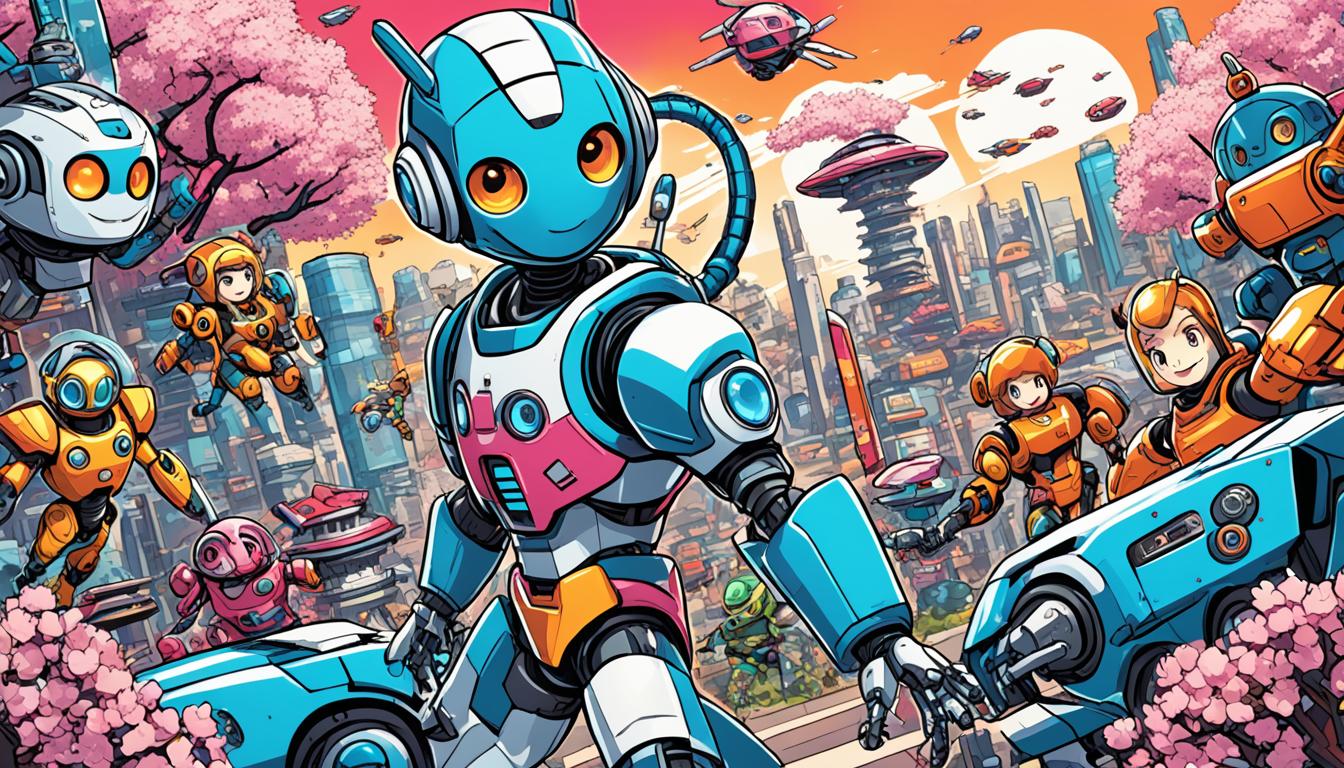Did you know that WEBTOON, a popular webcomic platform, has had an equal level of popularity for both its digital and physical copies of titles?
Anime and manga are making big waves worldwide. They’re known for their interesting stories and bright artwork. Thanks to new technology and changing habits, they’re constantly changing.
More and more people are reading these stories online. This is bringing in fans from all over the world. The way these stories are told and shared is evolving fast.
Key Takeaways:
- The success of WEBTOON showcases the potential for online platforms to revolutionize manga publishing and attract a global audience.
- American fans are increasingly embracing legal streaming sites, shifting their preference from physical copies to digital access.
- The Japanese anime industry faces the challenge of offshore production and potential bypassing of American distributors.
- The influence of anime has spread beyond traditional forms of media, with fans expressing their support through cosplay, fan art, and webcomics.
- The future of the US anime industry remains uncertain, but the enduring power of storytelling and the universal appeal of anime and manga are expected to drive its continued growth.
The Inner Workings of the Industry
The Japanese entertainment world is dynamic and includes many skilled people. They work on anime and manga, such as anime creators and manga authors. They make sure we get great stories and amazing art.
In 2022, the anime business reached a huge ¥2.74 trillion. This is approximately €175 billion or US$194 billion and shows its success. At the same time, manga sales hit ¥677 billion. This is around €4.3 billion or US$4.8 billion, proving how loved this art is.
Freelancers are a big part of Japan’s creative work, with many working in anime and manga. They make up a quarter of the industry’s workforce. It shows how important they are for creating these forms of art.
There are groups and centers that help those in the industry, like the Wor-Q center. Part of the Japan Trade Union Confederation, it helps over seven million people stand together. They work for better working conditions.
But, making anime overseas might affect its quality. The shift to foreign studios could change the special look of Japanese anime. It might not be as unique or authentic.
Also, making anime now is much faster. Creators have to finish a season in just three months. This means they’re under a lot of pressure. It could affect their health and the quality of what they make.
Money for making anime hasn’t grown, even though the work has. This could hurt the creators and the quality of the anime we love. It might be time to rethink how funds are used and supported.
Some call this fast growth a “production bubble.” It means studios are in a rush. This can lead to stories that feel hurried and more focus on making money than art.
Digital formats have changed how manga is made. Now, artists can publish more flexibly. With the decline in print and rise of online, they can reach more people and be more creative.
To really get how this industry works, we need to look at all the different people involved. About half of the anime’s budget goes to the studio. The other half helps pay broadcasters and others in the project.
Here is a table showcasing notable statistics related to the anime industry:
| Statistic | Value |
|---|---|
| Anime Industry Revenue (2022) | ¥2.74 trillion (€175 billion or US$194 billion) |
| Manga Comic Books and Magazine Sales (2022) | ¥677 billion (€4.3 billion or US$4.8 billion) |
| Percentage of Self-Employed Workers in Japan | 25% |
| Number of Union Members Represented by JTUC-RENGO’s Wor-Q Support Center | Approximately 7 million |
These numbers show how big and diverse the anime and manga world is. Knowing how it all works makes us value the hard work of everyone, from creators to freelancers, in making the entertainment we enjoy.
Challenges and Advocacy
The anime industry in Japan has been growing fast. In 2022, it made a record of ¥2.74 trillion. This is about €175 billion or US$194 billion. However, workers face poor conditions and the content quality is dropping. This pushed the formation of the Nippon Anime & Film Culture Association (NAFCA).
NAFCA was started by people who work in anime. They saw the problems and wanted to help. Their goal is to make things better for creators, animators, and others. They want to improve support and change policies to protect these workers.
One big issue is bad working conditions. Many say the content quality has dropped. Young animators don’t get enough training. This puts them in tough spots because some companies treat them unfairly.
NAFCA wants to fix these problems. They work with companies, the government, and unions. Their aim is to make the anime industry a fairer place for everyone working in it.
“NAFCA’s start is a big step towards making anime work conditions better. Providing support and training for young talent is essential. Fair treatment for all professionals is key,” says Yukari Nishino, director of Wor-Q support center.
NAFCA wants to help new animators and those starting in the industry. They plan to offer good training and support. This will give the next generation the skills they need to succeed.

| Statistics | Salary Comparison |
|---|---|
| Entry salaries for American animators: | Average entry salary is $68,661[2] |
| Entry salaries for Japanese animators: | Around $20,000 or lower, depending on employment type[11] |
| JTUC-RENGO members: | About seven million[4] |
NAFCA’s work is not only in Japan. They are also tackling global issues. As the world gets smaller, it’s important to keep Japanese animation’s unique charm. This is vital for its culture and identity.
NAFCA is making a difference by talking and taking action. They are working to make the anime world better for everyone. Their aim is to ensure anime’s future is both creative and fair.
The Impact of New Technologies
Technology has changed how anime is made, both in good and bad ways. Now, animators can use tools like Maya and 3D Max for amazing 3D work. This makes their animations more real and beautiful than ever.
But, making anime in other countries to save money is a growing trend. This can lower the quality because there’s less training for new animators. The skills in the anime world might not grow very fast because of this trend.
Virtual reality (VR) is starting to be used in anime, offering new experiences. It puts viewers right in the middle of the action. This means new ways of telling stories and getting the audience involved.
Thanks to 3D printing, making detailed props for anime has become easier. Places like Propshop at Pinewood Studios can now make highly detailed models. This makes anime worlds look even more realistic.
Making anime digitally has made the production process better. Filmmakers can use top-tier equipment and techniques, making their anime look fantastic. It’s a step forward in how good anime can look.
Also, new tech lets filmmakers in different places work together easily. This means anime can be made by people across the globe, bringing in lots of different ideas. It makes anime more creative and diverse.
There are even tools now that help with making animations more dynamic. Depth sensors, for example, pick up on how things move in space. This lets animators craft more engaging scenes.
Overall, technology has deeply changed the anime world. It has opened up amazing new ways to create. But, challenges like the quality of work and training new artists still need attention. Finding a balance between tech and tradition is key for the anime world’s future.
The Evolution of Anime
Anime has grown a lot over the years, enchanting people worldwide with its special looks and stories. Despite its success, some worry about where anime is heading today.
Sociologist Renato Rivera Rusca talks about an issue in the anime world. He says there’s too much pressure on creators to finish things quickly. This focus on making money can harm the quality and creativity of anime.
“The anime industry is experiencing a production bubble, with creators facing a constant rush to meet tight deadlines. This rush often leads to compromises in creativity and storytelling, as commercialization takes precedence over artistic vision.” – Renato Rivera Rusca
Today, making more money and becoming famous globally are big goals for anime. But, this has led some shows and movies to focus more on being popular than on being truly creative. This could make Japanese anime less varied and unique, which might be bad for its future.
But, not all anime is made this way. There are still many studios and creators who make unique and thought-provoking anime. These shows find a balance between being entertaining and artistically meaningful. They’re the ones keeping the anime world interesting and diverse.
A better, more balanced way to make anime is needed for its future. It’s important to value creative freedom and artistic quality as much as making money. This way, new talents can emerge, and the creativity in anime can keep flourishing, bringing us more amazing stories and art.
As fans of anime, we should support the creators who make quality and original content. By doing so, we can help keep the anime world vibrant and moving forward. Supporting a fair approach to making anime is supporting its future as a beloved storytelling medium.
| Year | Significant Events |
|---|---|
| 1907 | Release of the first Japanese animated film, “Katsudo Shashin,” setting the stage for anime as a storytelling medium. |
| 1963 | Introduction of “Astro Boy” by Osamu Tezuka, a groundbreaking work exploring themes of artificial intelligence and ethical dilemmas. |
| 1988 | Studio Ghibli produces “My Neighbor Totoro,” contributing to the global recognition and appreciation of anime. |
| 2001 | “Spirited Away” wins the Academy Award for Best Animated Feature, solidifying the international acclaim for Japanese anime. |
Anime has grown from its early days to being known all over the world. It’s become a big part of both Japanese culture and global entertainment. By facing and solving today’s challenges, we can keep anime alive and inspiring for future generations.
The Cultural Significance of Anime
Anime is not just a TV show, it’s something people all over the world love. It comes in many genres like action, romance, and more. This means there’s a story for everyone out there.
It’s so easy to watch anime now, thanks to streaming services. Platforms like Netflix and Crunchyroll let fans enjoy shows anywhere, anytime. This has helped anime become a favorite of fans from many different countries.
“Anime has transcended cultural boundaries and become a global phenomenon, captivating viewers with its unique storytelling and captivating visuals.”
But anime is more than just shows. In Japan, places like anime cafes and shops draw in fans from everywhere. The government there even supports anime tourism. They do this by promoting events and locations in anime through special websites.
However, there are tough issues in the anime industry, like low pay and harsh work conditions for young animators. It’s important to give these creators more support and better rules.
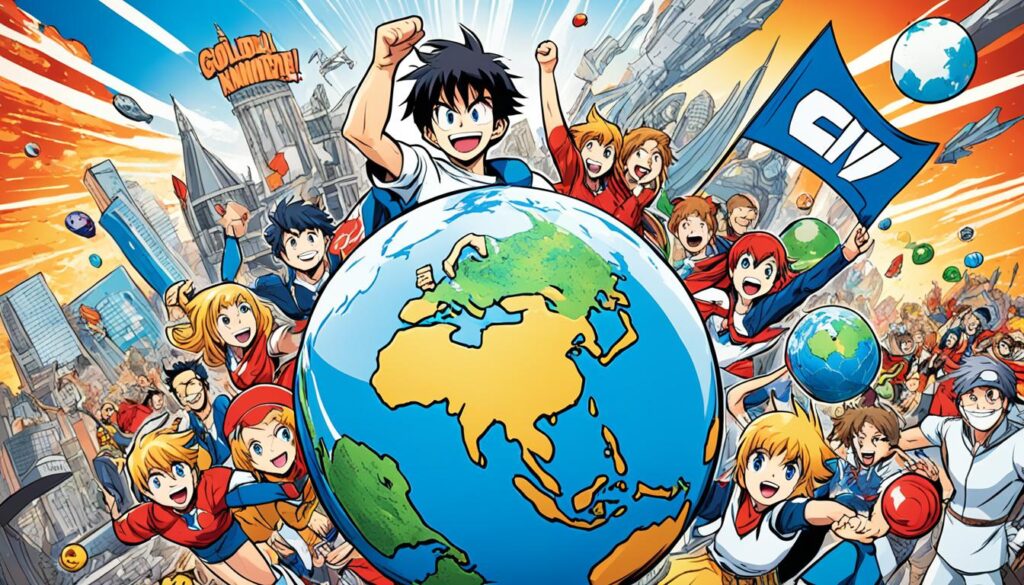
| Statistics | Data |
|---|---|
| Anime industry worth (Japan) | $20 billion |
| Anime industry market size (Japan, 2019) | 2.15 trillion yen |
| Jobs created by anime industry (2017) | 153,000 |
| Export value of anime-related products (Japan, 2019) | $3.4 billion |
These numbers show why anime is so important and loved worldwide. As the industry grows, we must make sure that those who create anime get fair treatment. Their stories bring joy to millions, and they deserve good pay and conditions in return.
The Influence of Traditional Art
Traditional Japanese art greatly influenced the way stories are told in modern manga. Katsushika Hokusai is a key figure in this. His collection, Hokusai Manga, made during 1814-1834, inspired many manga artists today.
When we look at Hokusai’s work, we see a bridge to modern manga. His details and emotions shine through. Scenes of people, places, and nature in his art laid the groundwork for manga’s style and depth.
Hokusai didn’t just paint; he captured the soul of Japan. Today, manga artists mix these traditional roots with their own flair. This mix points to manga’s growth as an art.
This famous woodblock print, “The Great Wave off Kanagawa” by Hokusai, shows his genius. Its beauty and power reflect his deep respect for nature and his skill in art.
The Rise of Studio Ghibli
Studio Ghibli was founded by Hayao Miyazaki, a famous filmmaker. It’s known all over the world for its unique stories and beautiful art. Thanks to them, anime now has many fans globally.
Movies like “My Neighbor Totoro” and “Spirited Away” are very loved. They show how amazing Japanese animation can be. “Spirited Away” especially did very well, breaking many records.
“Spirited Away” made a lot of money in Japan right after it came out. It broke the record for the most money made in one weekend. The film also became the highest-earning movie in Japan ever, making over $300 million (source: Box Office Mojo).
“Spirited Away” won a big award in Berlin in 2002. It was the first animated movie to get that prize. This showed everyone that Studio Ghibli’s work is truly special.
In 2003, it won an important award in Hollywood, too. This was the first time a movie in a different language won. It was a big deal for Studio Ghibli (source: The Guardian).
“Spirited Away” did really well outside of Japan, too. It made more money than “Titanic” in Japan. This showed the world how great Ghibli’s movies are. Even their previous movie, “Princess Mononoke,” hinted at their future success.
Before “Spirited Away,” “Princess Mononoke” had already beaten “Titanic” in Japan. This was a big achievement at that time (source: The Japan Times).
Disney started working with Studio Ghibli in 1996. This partnership helped Ghibli’s movies reach more people around the world. It let everyone see the unique stories and cultures Ghibli shares through its work.
Starting with movies like “Kiki’s Delivery Service,” Ghibli saw a lot of success in Japan. This success continued with “Spirited Away” (source: The Japan Times).
Studio Ghibli has changed the animation world a lot. Miyazaki’s dreams and Ghibli’s focus on great art have made a lasting mark.
Steve Alpert: A Key Figure in Studio Ghibli’s International Reach
A significant contributo
The Cultural Impact of Anime
Anime is now a major part of Japanese culture. Over the years, it has affected entertainment, fashion, and technology. Because of its immense popularity, anime is everywhere in Japan.
Entertainment: Anime attracts people of all ages with its unique stories and stunning art. Studios like Studio Ghibli are famous worldwide for films like “My Neighbor Totoro” and “Spirited Away.” These films help people outside Japan see the magic of anime.
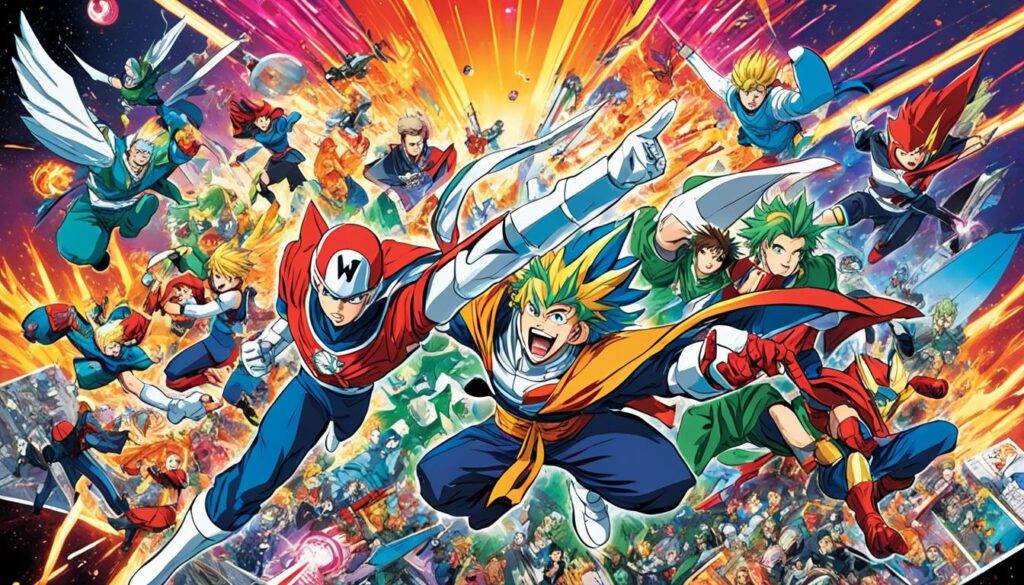
Fashion: The world of fashion looks to anime for new ideas. Its characters have influenced what people wear and how they style their hair. And dressing up as anime characters, known as cosplay, is a big part of the culture.
Technology: Anime has also pushed technology forward. It constantly uses new animation and storytelling methods. This leads to things like virtual reality games and apps, bringing the anime world to life in new ways.
###
Tabel: Economic Impact of the Anime Industry in Japan
| Year | Industry Worth (USD) | Market Size (JPY) | Jobs Created | Export Value (USD) |
|——|———————|——————-|————–|———————|
| 2020 | $20 billion | 2.15 trillion yen | 153,000 | $3.4 billion |
Anime’s impact on Japan’s economy is huge. In 2020, it was worth over $20 billion. This shows how important anime is to Japan’s economy.
It also creates a lot of jobs, over 153,000 in 2017. The work it provides is essential for many people.
And anime products’ export is growing, reaching $3.4 billion in 2019. This shows how much the world likes Japan’s anime.
Fans often visit Japan because of anime, boosting the local economy. This leads to more anime-themed places, like cafes and shops, which also help Japan’s economy.
The Legacy of Osamu Tezuka
In the world of manga and anime, Osamu Tezuka shines the brightest. He was born on November 3, 1928, in Toyonaka, Osaka, Japan. Tezuka is known as the “Godfather of Manga.” He changed the game with his amazing creations.
His manga journey started in the 1940s. This was while he was studying to be a doctor. He made manga popular for all ages with works like “Astro Boy.” This was the start of manga’s golden era.
Astro Boy began in 1952. It broke the idea that comics and animation were just for kids. Its success launched a new era for manga.
“Astro Boy” became a global hit. This manga showed that comics could tell deep, rich stories. It led to Japan’s first animated TV show based on a comic in 1963.
Tezuka’s works expanded the boundaries of storytelling, pushing the medium to new heights of creativity and imagination.
Tezuka loved manga so much that he started a school for young artists in 1959. It was called the “Osamu Tezuka Manga Academy.” This school inspired many manga creators.
All through his life, Tezuka won many awards for his work. In 1961, he got the Bungei Shunju Manga Award for “Message to Adolf.” He also won the Shogakukan Manga Award in 1975 for “Phoenix.”
Even after Tezuka passed on February 9, 1989, at 60, his work lives on. He influenced famous artists like Katsuhiro Otomo, Akira Toriyama, and Naoki Urasawa.
Tezuka’s stories and deep themes still inspire manga and anime fans today. Many of his works have been remade or turned into new series. “Astro Boy” and “Dororo” are just two examples.
Tezuka’s works are still loved and adapted. They show how powerful and special manga and anime can be. He will always be known as a pioneer. His work opened the door for others to dream big in manga and anime.
| Notable Works | Years |
|---|---|
| Astro Boy (Tetsuwan Atom) | 1952-1966 |
| Jungle Emperor (Kimba the White Lion) | 1950-1954 |
| Ayako, MW, Ode to Kirihito, Black Jack, Buddha | 1960s |
WEBTOON’s Impact on the Industry
Digital comics, led by platforms like WEBTOON, are changing the manga world. WEBTOON, a manga company, has introduced a fresh way to read and share comics. This is thanks to its digital approach.
Notably, WEBTOON is very easy to get into. It’s different from the usual manga you might buy. Here, you can read manhwa, or Korean comics, for free or very little. Because of this, people from all over are enjoying comics more than ever before.
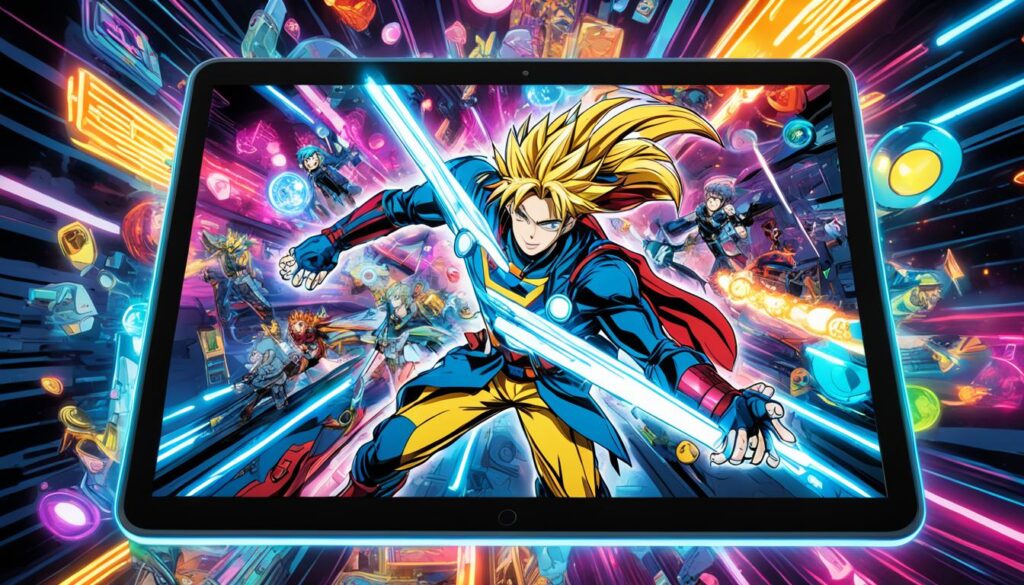
WEBTOON stands as the world’s top webcomic publisher. It has found a way for people to read comics on their devices easily, always within reach. Its smart move into print editions has also made it more popular.
Take, for instance, the success of Tower of God, a WEBTOON series. The devotion of its fans helped it get turned into an anime. This shows how much reader passion can influence what stories get brought to life.
In the bigger picture, Japanese publishers have been slower to embrace these changes. The stories and looks of Korean manhwa are quite different, making it hard for some to accept. Yet, Tower of God’s anime success could change that, pushing Japanese manga to try new things.
Digital comics like WEBTOON have grown mainly because younger people love online content. These platforms offer all sorts of stories, from love tales to scary adventures. It’s no wonder they are now a favorite place for those looking for new tales to love.
South Korea started making webtoons big in the early 2000s, with places like Naver Webtoon and Daum Webtoon getting in early. Now, these webtoons are known worldwide. This has led to all sorts of cool stuff, like shows, items, and events just for fans.
Webtoons let new talent get their comics out to the world. The way webtoons are told, with stories that keep you hooked, makes people really get into reading them. Fans and creators come together, making a lively community.
This new era in storytelling has made webtoons very popular. They offer unique stories full of real feelings. This is something many readers really connect with, and it’s part of why webtoons are so well-liked.
Big webtoon places like LINE Webtoon and Tapas share many kinds of webtoons. You can read a lot for free. These sites make money through ads or by letting you choose to support the creators with a small payment.
Webtoons are clearly making a big mark in the manga world. They are changing how people read comics and are beloved all over. In many ways, they are leading the way, showing a different future for comic storytelling and winning the hearts of readers worldwide.
The Future of Manga Publishing
Since 2004, WEBTOON, created by JunKoo Kim, has been changing the way we read comics with its app. It’s now a top player in the manga world, always growing and using new tech. With plans for Webtoon Unscrolled and a new focus on print comics, WEBTOON’s future looks exciting.
The love for web comics has helped WEBTOON thrive. Even as manga sales rise, the fight for readers and licenses grows. WEBTOON’s global fan base and its opportunities for Japanese artists are a winning combo.
While digital comics are big, people are starting to like print books and anime again. This means good business for companies making traditional comics. Bookstores and big retailers are seeing more manga on their shelves.
WEBTOON Unscrolled is betting big on romance, planning to release more books each year. They’re listening to what readers want, showing they’re in it for the long haul. These efforts will keep WEBTOON on top.
We’re in a tough economy, with high costs and supply problems. But, publishers are staying positive and making content that everyone loves. They see chances for growth in the next five years.
Manga is doing better than ever, beating big names and even getting on the New York Times list. This has inspired Western companies like Marvel and DC to start making manga too.
| Manga Title | Authors | Release Date |
|---|---|---|
| Fake Rebellion | Yuuchang Sasaki | March 2024 |
| Endroll Back | Kantetsu and Haruna Nakazato | April 2024 |
| Momo: Legendary Warrior | Yuji Kobayashi, Z-ONE, and Naoto Tsushima | May 2024 |
| Kerberos in the Silver Rain | Lira Aikawa | June 2024 |
| Kinryo Rock | Bingo Morihashi and Manabu Akishige | July 2024 |
The future of manga is bright, thanks to change and ease of access. Making manga local might lead to more money and fun new titles. This variety is good for manga and comic books overall.
The future of manga looks good, with WEBTOON at the forefront. Manga keeps winning over the world, thanks to great stories and art. Its future is full of possibilities.
The Changing Landscape of Manga
The manga world is changing fast, thanks to online comics. These web comics are becoming more popular because they’re easy to find and don’t cost much. As a result, both creators and readers are turning to digital manga more than ever before.
Web comics make manga much cheaper than the printed versions. This affordability is catching the eyes of many people who might not have looked at manga before. So, lots of new fans are diving into the world of manga because it’s easier on their wallets.
“The adaptability of web comics has transformed the manga industry.”
Reading manga online is super convenient. You can read your favorite titles on your phone, tablet, or e-reader from anywhere. This means manga is no longer limited by where you live; it’s now available to fans all over the globe.
Technology is also changing how manga stories are told. Web comics can use animation, sound, and music to bring the stories to life. This mixed-media approach makes manga even more exciting, drawing in readers of all ages.
Web comics are breaking free from old rules, letting creators be more daring and creative. This has led to a huge variety of genres and stories, making manga more interesting to everyone. Now, every reader can find something they love in the vast world of manga.
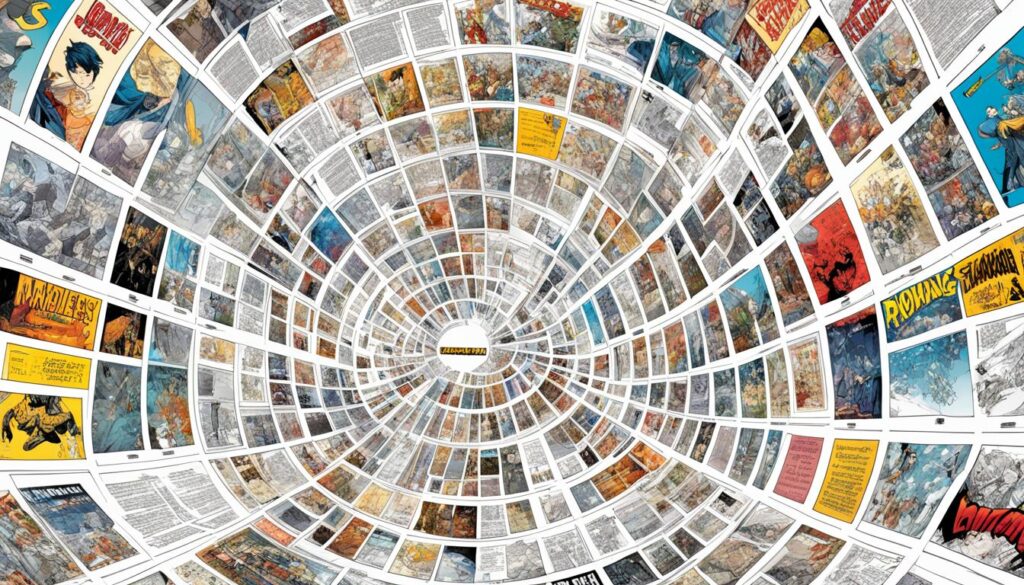
| Age Group | Percentage of Manga Readers |
|---|---|
| Before the age of 10 | 15% |
| Between 10 and 14 | 45% |
| Secondary school-aged | 29% |
Manga is more than just stories now. It’s a way for people around the world to share their culture and experiences. Through manga, young readers can learn to see the world from new angles, which helps build empathy and understanding.
This change in the manga world is great for everyone involved, from readers to creators. Web comics open up new doors for artists to reach a wide audience. This is an exciting chance for fresh talents to shine in the manga scene.
The future of manga looks very bright indeed. With online comics, the world of manga is growing, becoming more diverse and creative. This is an exciting time for manga fans and creators as we see where this digital era takes us.
Conclusion
Anime and manga captivate people everywhere with their stories, broad appeal, and beautiful art. We’ve looked at their deep history and meaning in this piece.
Japanese tradition mixes with Western ideas in anime and manga. They bring together a cultural blend that attracts fans worldwide. This art form keeps growing, welcoming new themes and styles.
Looking at 10 anime series, we saw stories filled with emotion and surprising turns. They often talk about big themes like sacrifice and finding yourself. Viewers connect deeply with the characters, making each ending special.
These anime stories show the strength of good storytelling. They prove how this art form speaks to everyone. As anime and manga keep evolving, they keep winning over new fans and breaking creative limits.
FAQ
What is the future of anime and manga?
The future looks bright for anime and manga. They still excite people all around the globe. Their popularity and new ideas will keep growing.
Who are the key professionals involved in the anime and manga industry?
In this field, you have anime makers and manga writers. You also find folks in animation studios and those who work for themselves. They all help make anime and manga better.
Are there any organizations advocating for better working conditions in the industry?
Yes, the Nippon Anime & Film Culture Association works on this. They address the tough work conditions and a drop in content quality. Their aim is to safeguard anime as a true art.
What is the impact of new technologies on the anime industry?
Modern tech, like digital tools, offer new chances to creators. But, sending anime work abroad might lower its quality and make it harder for young animators to learn.
How is the artistry and storytelling potential of anime showcased internationally?
Studio Ghibli, started by Hayao Miyazaki, has really made anime stand out worldwide. Movies like “My Neighbor Totoro” and “Spirited Away” have won hearts everywhere. They show just how special Japanese animation is.
What is the cultural impact of anime?
Anime has touched many parts of Japan’s culture, like its fun, fashion, and tech. It’s loved by people of all ages and has made things like anime gear, dressing up as favorite characters, and themed cafes very popular.
How has traditional art influenced modern manga?
The traditional art of people like Katsushika Hokusai has shaped manga’s way of telling stories with pictures. This link between old art and manga today shows how manga has grown over time.
Who is considered the “Godfather of Manga”?
Osamu Tezuka gets this title for changing manga with his amazing work. Characters like “Astro Boy” have added deep stories and new art forms to anime and manga.
What impact has WEBTOON had on the manga industry?
WEBTOON has really changed the manga world with its online comics. People love its unique way and easy access. Now, WEBTOON is big all over and even in print.
What is the future of manga publishing?
Manga will mostly be online in the future because it’s easy to find and read. But, manga books are still loved and are key in the business.
How does anime and manga continue to resonate with audiences?
Anime and manga are more than just stories. They’re culture that keeps evolving with creativity and love. The support of fans worldwide keeps them going strong.
Source Links
- https://screenrant.com/webtoon-best-manga-manhua-industry-future/
- https://mangahelpers.com/forum/threads/the-present-and-future-of-the-us-anime-industry.75172/latest
- https://variety.com/2024/film/asia/manga-productions-essam-bukhary-saudi-manga-craze-1235939707/
- https://www.equaltimes.org/anime-and-manga-creators-dream
- https://washiblog.wordpress.com/2011/01/18/anime-production-detailed-guide-to-how-anime-is-made-and-the-talent-behind-it/
- https://aleccowan12.medium.com/how-anime-took-off-in-the-u-s-8d6354557867
- https://www.animenewsnetwork.com/feature/2021-07-21/i-have-some-horror-stories-animator-talks-industry-problems-hopes-for-the-future/.175178
- https://www.re-thinkingthefuture.com/architectural-community/a10806-the-role-of-technology-in-the-production-and-consumption-of-anime/
- https://www.toki.tokyo/blogt/2023/8/9/anime-and-manga-exploring-a-cultural-phenomenon
- https://www.leadbeltgamesarena.co.uk/the-global-impact-and-evolution-of-the-art-form/
- https://en.wikipedia.org/wiki/History_of_anime
- https://www.nippon.com/en/features/h00043/
- https://fastercapital.com/content/Anime–Exploring-the-Impact-of-Anime-on-JapanInc–A-Cultural-Phenomenon.html
- https://medium.com/@hasretceden/from-manga-and-anime-culture-to-the-culture-industry-bf6a051daa8e
- https://www.linkedin.com/pulse/anime-manga-global-influence-japanese-pop-culture-ak-japan-imports-dolcf
- https://time.com/6081937/spirited-away-changed-animation-studio-ghibli/
- https://ny.jpf.go.jp/event/exporting-studio-ghibli-the-road-to-worldwide-recognition/
- https://www.toonsmag.com/world-of-manga-osamu-tezuka-and-his-influence/
- https://gamerant.com/how-osamu-tezuka-influenced-the-world-of-manga-and-anime/
- https://www.cbr.com/webtoons-future-of-anime/
- https://www.toonsmag.com/the-rise-of-webtoons/
- https://www.comicsbeat.com/sdcc-23-manga-industry-publishing-roundtable/
- https://www.cbr.com/manga-comic-books-marvel-dc/
- https://www.bbc.com/culture/article/20190610-did-manga-shape-how-the-world-sees-japan
- https://different-level.com/anime-manga-or-how-japan-became-international/
- https://eng345anime.wordpress.com/2019/04/22/cartoons-and-anime-conclusion/
- https://www.watchmojo.com/articles/top-10-anime-conclusions
